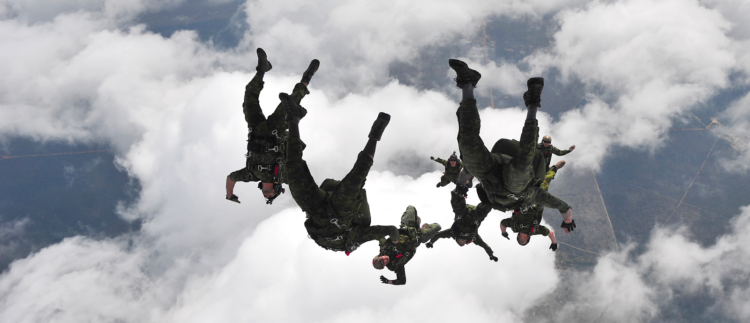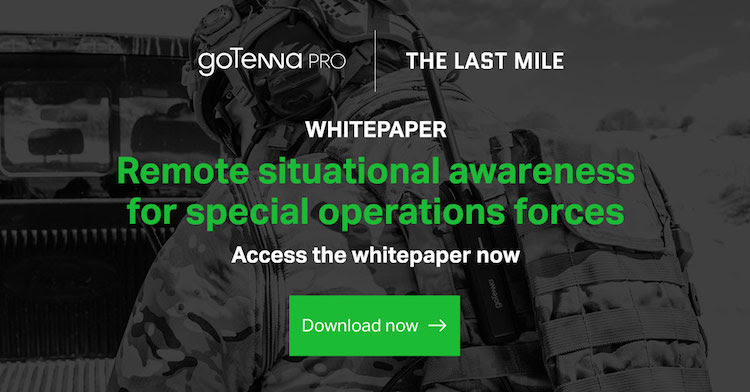Leveraging mobile mesh for safer, more connected military freefall operations

With a hundred mile per hour winds pelting water at their skin, dense jungle canopies covering their drop zone, and overwhelming darkness blinding their path, the Military Assistance Command – Studies and Observations Group’s (MACV- SOG) six-man recon team made history as they plummeted into foreign territory for the first time. Since that first high-altitude, low opening jump (HALO) jump amidst the Vietnam war, military freefall has been an imperative part of military operations. From airdropping relief supplies and equipment via Joint Precision Airdrop Systems (JPADS), to paratrooping into unknown conditions, there have been significant advancements in military freefall operations in the past five decades.
Despite its importance, military freefall operations are not without many risks. Aside from the injuries that warfighters and tactical operators can experience – including common injuries such as sprains and fractures – there is also the risk that an operator can get lost. When you consider that some military freefall operations are conducted at night, and others may be conducted in emergency response scenarios, it becomes very easy to understand how a senior leader can lose track of a tactical operator during combat operations.
Also, when you consider that some of the parachutes being deployed belong to JPADS and not people, it becomes even easier to see how they can be lost. All of us have dropped something small from standing height onto a hard surface and then scrambled on our hands and knees to find it – only to realize that it somehow managed to make its way under the couch. Now imagine we’re dropping something large, but from 30,000 feet in the air. At night.
Military freefall operations had no tool for sharing their Position Location Indication data (PLI data). Each jumper stood on that ramp prepared to dive into austere environments with unknown obstacles, such as rugged terrain, harsh weather, nighttime conditions, bodies of water, and other topographical features with limited location, communications, and situational awareness resources.
“…even with the many advancements that have been made in communications and situational awareness tools, modern tactical operators still often find themselves relying on less advanced solutions such as a dive compass, maps, IR strobes, and searching for the red or green lights on combat gear to track their fellow soldiers.”
However, even with the many advancements that have been made in communications and situational awareness tools, modern tactical operators still often find themselves relying on less advanced solutions such as a dive compass, maps, IR strobes, and searching for the red or green lights on combat gear to track their fellow soldiers. For rare scenarios like the lost jumper, troops depend on luck and a good eye to locate each other.
Thankfully, advancements in communications and situational awareness tools have made it possible for tactical operators in military freefall operations to broadcast and receive PLI data. This increases situational awareness, and allows teammates in the field – as well as senior leaders back at home – to see the physical location of all tactical operations during and after a military freefall operation.
And one of the technologies making this all possible is today’s advanced mobile mesh networking solutions.
Mobile mesh passes the test for military freefall
Representatives from mobile mesh networking solution provider, goTenna, recently conducted field tests in conjunction with the military to identify how this new technology could be leveraged in military freefall operations. And the results were incredibly exciting.
In many modern military PACE plans, voice has played the part of the primary communication strategy leveraging voice comms, tactical operators can communicate to share drop zone coordinates, and share their locations using coordinates, maps, compasses, and GPS coordinates following a jump. This was the intention going into the field tests – voice being the primary form of communication, with the mobile mesh networking devices available as alternative comms should voice communications fail.
However, that quickly changed as the field tests progressed.
Issues often arise when trying to leverage voice comms to communicate on a helicopter, locate soldiers in an off-grid environment, or achieve situational awareness in night-time operations. The noise of an aircraft makes voice comms difficult to hear and understand. Lack of visibility, darkness, and canopies can make it hard to physically spot the landmarks that tactical operators may be describing on the ground from the air. And the lack of traditional terrestrial networks can make it impossible to leverage applications – such as ATAK – in the locations where these operations take place.
“While military freefall operations have evolved significantly since their inception during the Vietnam War, the technologies that tactical operators leverage for communications and situational awareness during these missions have lagged behind.”
Mobile mesh networking solutions solve all of these problems. By simply deploying a goTenna Pro device with each tactical operator involved in the military freefall field tests, team members were able to communicate clearly with each other and senior leaders via text, even when in a noisy aircraft. Since mobile mesh networks can enable the off-grid use of ATAK, every tactical operator was represented on a map, which made tracking their location and finding them should they be lost much easier and faster.
With these benefits and features on display, the goTenna Pro devices quickly began to overtake traditional voice comms as the preferred communications method during the field tests. In fact, it wasn’t long until ATAK on mobile devices connected via goTenna mobile mesh was the primary form of communication during the operations.
But there are more benefits to mobile mesh for military freefall than simply providing visual communications and situational awareness. It can also help keep tactical operators safe and hidden from the radar of adversaries.
The radio signals utilized in traditional voice comms can alert adversaries to the presence and locations of tactical operators. Each voice comm transmission takes five to ten seconds. If used frequently in enemy-controlled areas, this gives them catastrophic exposure to their adversaries.
In contrast, the goTenna mobile mesh networking devices have the ability to “hide in the noise” – leveraging short, small bursts of signal that get lost in the other electronic signals around them. This makes it much more difficult for adversaries to identify the presence and location of allied warfighters. Also, since the communication is visual (text) and not voice, mobile mesh makes it much easier to communicate without audible noise – making it ideal for special operations and other stealth missions.
With that being said, though mobile mesh networking proved to be beneficial during the military freefall field tests, there are always ways to make things better.
Making mesh better for military freefall
Based on the lessons learned and data generated during the field tests with 6-12 skydivers, goTenna is exploring tweaks it can make to the hardware, software, and accessory kits to make the solution even more effective for military freefall in the future. Battery conservation, mounting adjustments, and adding a jump mode were all things goTenna is looking to explore.
The battery life of the goTenna at a 5-second PLI was around 1.5 hours. Adding a backup battery pack to these portable nodes would create a longer-lasting power bank and help to conserve energy. When these mobile mesh nodes are in military freefall, they project a faster PLI data signature. goTenna is exploring the potential of adding a jump feature that would project standard PLI until it needs to be ramped up to that higher setting. This would conserve the extra power and aid in battery conservation.
“The noise of an aircraft makes voice comms difficult to hear and understand. Lack of visibility, darkness, and canopies can make it hard to physically spot the landmarks that tactical operators may be describing on the ground from the air. And the lack of traditional terrestrial networks can make it impossible to leverage applications – such as ATAK – in the locations where these operations take place.”
The company is also planning to work with its partners, including Bunker, Juggernaut Case, and Mystery Ranch, to identify solutions for challenges that tactical operators faced when looking to mount their goTenna devices to their kits or vehicles. During the field tests military freefall jumpers express difficulty with attaching the goTenna node to the aircraft and their personal kit without compromising line of sight with imperfect antenna placement. Taking this knowledge to their partners, goTenna plans on identifying new vehicle mount and case alternatives that are custom-tailored for the harsh nature of military freefall missions.
While military freefall operations have evolved significantly since their inception during the Vietnam War, the technologies that tactical operators leverage for communications and situational awareness during these missions have lagged behind.
Mobile mesh networking can make situational awareness and communications easier for these incredibly intense, incredibly dangerous missions, ensuring that every warfighter can communicate, and nobody is ever lost.









No Comment